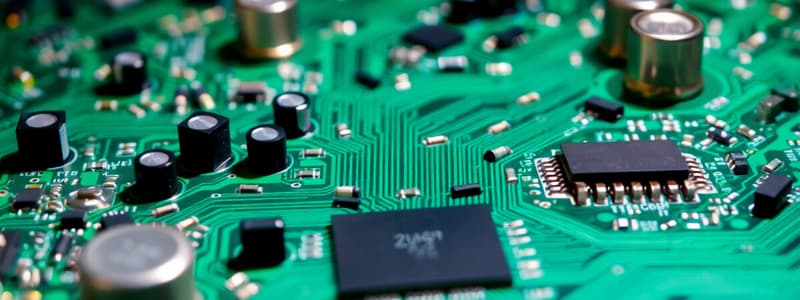Podcast
Questions and Answers
What distinguishes a double-layered PCB from a single-layer PCB?
What distinguishes a double-layered PCB from a single-layer PCB?
- Double-layered PCBs only support digital circuits, while single-layer PCBs are for analog circuits.
- Single-layer PCBs are always smaller in size compared to double-layer PCBs.
- Single-layer PCBs use surface mount technology, while double-layer PCBs use through-hole technology.
- Double-layered PCBs have conductive tracks on both sides of the board, allowing for more complex connections. (correct)
What is the primary purpose of vias in a double-layered PCB?
What is the primary purpose of vias in a double-layered PCB?
- To dissipate heat generated by the components.
- To mount components on the board.
- To provide electrical connections between the layers of the board. (correct)
- To insulate the conductive tracks from each other.
In PCB construction, what is the role of the 'substrate'?
In PCB construction, what is the role of the 'substrate'?
- It provides the mechanical structure and insulation for the board. (correct)
- It serves as the conductive pathways for electrical signals.
- It is an adhesive layer that binds components to the board.
- It acts as a heat sink to dissipate thermal energy.
What material are the conductive tracks on a standard PCB typically made of?
What material are the conductive tracks on a standard PCB typically made of?
What is a key characteristic of surface mount technology (SMT) in PCB assembly?
What is a key characteristic of surface mount technology (SMT) in PCB assembly?
In through-hole technology (THT), what is the function of 'vias'?
In through-hole technology (THT), what is the function of 'vias'?
Which phrase best describes the purpose of a PCB?
Which phrase best describes the purpose of a PCB?
If a PCB has components mounted on one side and conductive tracks on the opposite side, which manufacturing method is most likely used?
If a PCB has components mounted on one side and conductive tracks on the opposite side, which manufacturing method is most likely used?
What distinguishes a 'buried via' from a 'through-hole via' in a multi-layered PCB?
What distinguishes a 'buried via' from a 'through-hole via' in a multi-layered PCB?
Why are multi-layered PCBs used in complex electronic devices?
Why are multi-layered PCBs used in complex electronic devices?
What is a 'blind via' in the context of multi-layered PCBs?
What is a 'blind via' in the context of multi-layered PCBs?
A PCB is designed with components on one side and the traces on the opposite side. Due to space constraints, it is changed to have all components and traces on the same side. Which is the expected effect on manufacturing?
A PCB is designed with components on one side and the traces on the opposite side. Due to space constraints, it is changed to have all components and traces on the same side. Which is the expected effect on manufacturing?
What is the primary limitation of single-layer PCBs that leads to the use of double-layer or multi-layer PCBs in more complex circuits?
What is the primary limitation of single-layer PCBs that leads to the use of double-layer or multi-layer PCBs in more complex circuits?
What is the visual cue that conductive tracks are copper in a printed circuit board?
What is the visual cue that conductive tracks are copper in a printed circuit board?
What defines the complexity of a through-hole via in a multilayered board?
What defines the complexity of a through-hole via in a multilayered board?
What component mounting allows for components and conductive tracks sharing the same side of the board?
What component mounting allows for components and conductive tracks sharing the same side of the board?
What is another name for the tracks that are located on a PCB?
What is another name for the tracks that are located on a PCB?
Why is the base of the board also known as the substrate considered a dielectric material?
Why is the base of the board also known as the substrate considered a dielectric material?
What is the function of holes in the PCB?
What is the function of holes in the PCB?
Flashcards
Printed Circuit Boards (PCBs)
Printed Circuit Boards (PCBs)
Boards providing a convenient method to connect electrical and electronic components economically, found in nearly every electronic device.
PCB Base (Substrate)
PCB Base (Substrate)
The structural foundation of a PCB, acting as an insulator, often green or brown.
PCB Tracks (Traces)
PCB Tracks (Traces)
Conductive paths on a PCB that connect components electrically, typically made of copper.
Through-Hole Technology (THT)
Through-Hole Technology (THT)
Signup and view all the flashcards
Component Side
Component Side
Signup and view all the flashcards
Solder Side
Solder Side
Signup and view all the flashcards
Vias (in THT)
Vias (in THT)
Signup and view all the flashcards
Surface Mount Technology (SMT)
Surface Mount Technology (SMT)
Signup and view all the flashcards
Single-Layer Board
Single-Layer Board
Signup and view all the flashcards
Double-Layered Boards
Double-Layered Boards
Signup and view all the flashcards
Vias (in Double-Layer Boards)
Vias (in Double-Layer Boards)
Signup and view all the flashcards
Multi-Layered Boards
Multi-Layered Boards
Signup and view all the flashcards
Blind Via
Blind Via
Signup and view all the flashcards
Buried Via
Buried Via
Signup and view all the flashcards
Through-Hole Via (in Multi-Layered)
Through-Hole Via (in Multi-Layered)
Signup and view all the flashcards
Study Notes
- Printed Circuit Boards (PCBs) offer an economical method for connecting electrical and electronic components.
- PCBs vary in size and are used in virtually every electrical or electronic device.
Printed Circuit Board Construction
- PCBs have two main parts: the base and the tracks.
- The base (or substrate) consists of a dielectric material (an insulator) that provides the board's structure.
- PCB bases commonly have a green or brown color.
- Tracks (or traces) are conductive sections that enable electrical connections between components.
- Conductive tracks are made of copper and are "golden" in color.
- Holes in PCBs serve as mounting points for electronic components.
Component Mounting
- Components mount to PCBs in two ways: through-hole technology (THT) and surface mount technology (SMT).
- Through-hole technology (THT) involves components and tracks on opposite sides of the board.
- Vias are holes that component legs fit through, providing electrical connection between components and tracks.
- Surface mount technology (SMT) involves mounting components on the same side of the board as the tracks.
- With SMT, one side of the board goes essentially unused.
Single Layer Boards
- Single-layer boards represent the simplest PCB type, with tracks on only one side.
- With single layers, components usually mount on the opposite side using through-hole technology for space efficiency.
- Components can mount on the same side as tracks using surface mount technology when space isn't a concern.
- In single-layer SMT configurations, one side of the board remains essentially unused, and the circuit is typically simple.
Double Layer Boards
- Routing tracks face a significant limitation on single-layer boards,.
- Because tracks are conductors, their paths can not cross, making single-layer boards suitable for simple circuits with limited connections.
- Double-layered boards implement more complex circuitry
- Double-layered boards have tracks that run on both sides.
- Double-layered boards often combine surface-mount (SMT) and through-hole (THT) technologies.
- Vias (holes) provide an electrical connection between both sides of a double-layer board.
Multi Layer Boards
- Multi-layered boards facilitate highly complex circuits with many component connections.
- These boards feature multiple layers, each containing its own set of tracks and connections.
- A blind via has only one accessible end, linking an external layer to internal layers.
- A buried via has inaccessible ends, connecting internal layers to each other.
- A through-hole via has both ends accessible, linking all layers together.
Studying That Suits You
Use AI to generate personalized quizzes and flashcards to suit your learning preferences.


